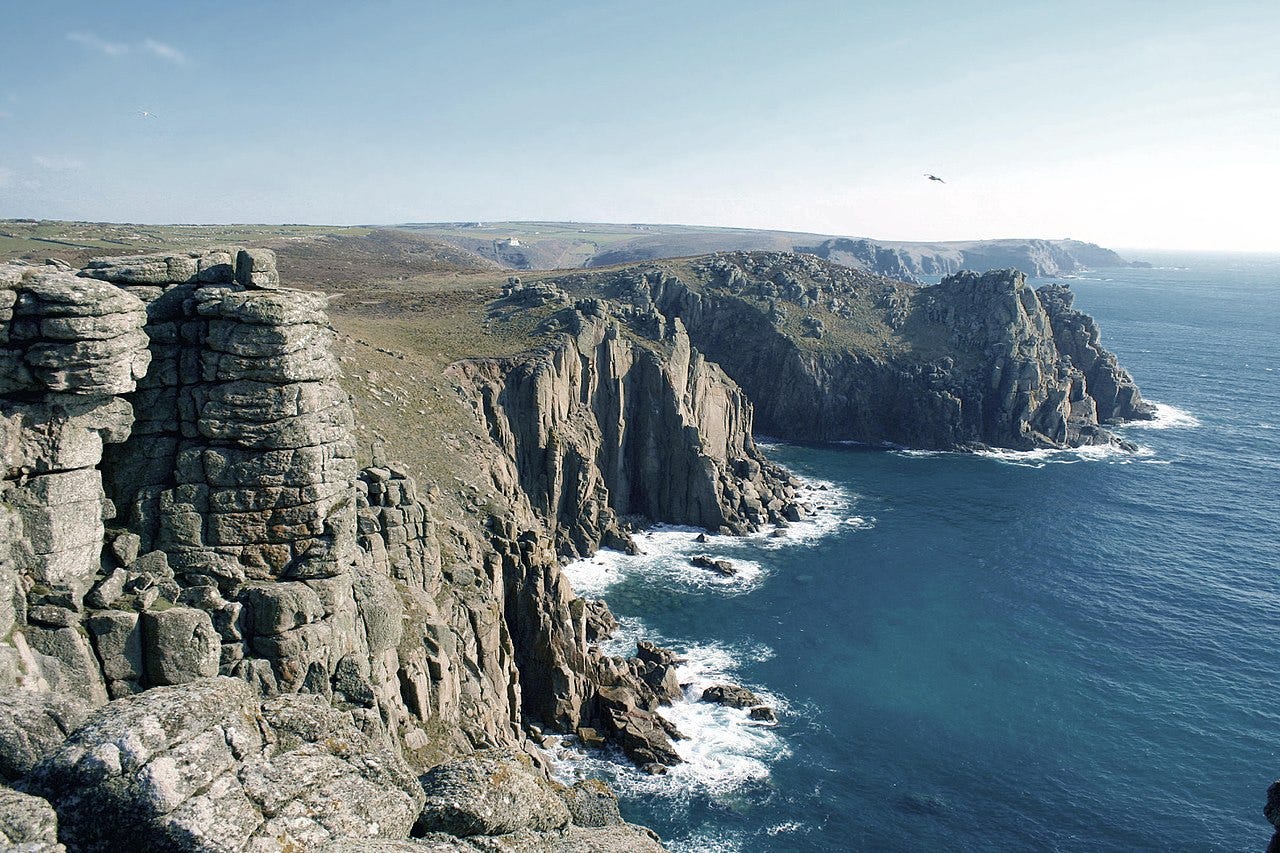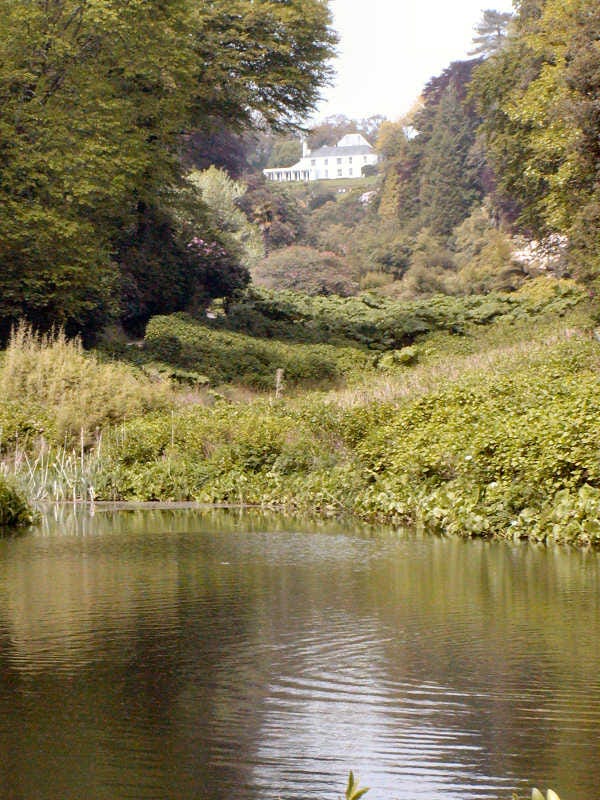Cormoran in Cornwall
Why speak of Cornwall when we know The Running Grave is largely set in London and Norfolk? Well, perhaps not for Strike 7, but I have reasons to believe that we will be coming back to Cormoran’s home county before the series ends. At some time between April and June 2020, J. K. Rowling followed the twitter accounts of two Cornish gardens: Trebah (@trebahgarden) and Glendurgan (@NTGlendurgan), both within the parish of Mawnen approximately three miles south of Falmouth. It is likely that she visited while scouting locations in Falmouth and St Mawes for Troubled Blood, but no other organisations, sites, hotels or pubs have had this honour. Following the accounts of non-political organisations is unusual for Rowling (unless they are particularly amusing), so I must conclude she was very taken with the gardens.
A garden in the correct location does make a cameo appearance in Troubled Blood, but this is hardly explanation enough.
‘And where would your garden be,’ asked Strike, ‘without tourists?’
‘Be ansom,’ said Polworth promptly, ‘We get a ton of local visitors, plenty of repeat business.’
Polworth had recently resigned from a managerial position in an engineering firm in Bristol to work as head gardener in a large public garden a short distance along the coast.
Troubled Blood p19
So I believe we will see a return to Cormoran’s home county, and we will see more of Dave Polworth’s place of work.
Cornwall and the Genesis of Cormoran Strike
Beatrice Groves has written about the Cornish origin of both the names: Strike and Cormoran.
Rowling has said that she found the name Strike “in a slim book about Cornwall.” My best guess is that the slim volume is Cornish Short Stories, which contains a murder mystery entitled “Corporal Strike.” Strike’s military title, the story’s genre, and the protagonist’s one-legged father, at least, all form tempting connections.
Beatrice Groves “Troubled Blood” in Cornwall
Cormoran is the legendary giant of St Michael’s Mount:
‘Have a seat,’ Fisher said to Strike, and he began to flit around the bookshelves that lined the walls. ‘Didn’t he live in St Michael’s Mount, the giant Cormoran?’
‘Yeah,’ said Strike. ‘And Jack’s supposed to have killed him. Of beanstalk fame.’
‘It’s here somewhere,’ said Fisher, still searching the shelves. ‘Folk Tales of the British Isles. Have you got kids?’
The Silkworm p41
Cormoran is a fascinating name, and probably of great antiquity. The name of course is cornish and means "blackberry giant", with cor meaning giant and moran meaning berry. Strictly morandu is blackberry, and his wife Cormelian means clover giant. The Cornish name for St Michael's Mount is Carrek Loos un Coos meaning grey rock in the wood, and refers back to prehistoric times when the bay was a low lying forest. It seems likely that Cormoran and Cormelian were originally pre-Christian nature spirits and this might appeal to Leda.1
A local legend tells that Cormoran constructed St. Michael’s Mount. According to folklore, he carried white granite from the mainland, at low tide, to build the island. The giant’s wife, Cormelian, assisted by carrying stones in her apron. When Cormoran fell asleep from exhaustion, she fetched greenstone from a nearer source. When she was halfway back, Cormoran awoke to discover her bringing different stones than he wanted, and kicked her. The stones fell from her apron and formed Chapel Rock.
Cormoran is often paired with Trecobben, the giant of Trencrom Hill in local folklore. The two are said to have thrown boulders back and forth as recreation. This is given as the explanation for the many loose boulders found throughout the area. In one version, the Trencrom giant threw an enormous hammer over for Cormoran, but accidentally hit and killed Cormelian and they buried her at Chapel Rock.2
Jack of the Hammer or Jack the Tinker is a traveling tinner (from Norway in some stories) who brought the knowledge of smelting tin to Cornwall (an honour shared with St Piran, Cornwall's patron Saint) and defeated the dark sorcerer the Lord of Pengersick (a wonderful Voldemort type character). He built the Iron Age hill fort to the north of Morvah known as Chun Castle, and inaugurated Morvah Fair. Many of the West Cornwall families are said to be descended from him.3
The Jack and Cormoranstory is likely to be a later conflation of the beanstalk tale, popularised inprinted literaturein the 18th century.
Because we know that Rowling is familiar with the Jack-the-giant-killer tale, it is tempting to speculate, as John Granger has done, that Strike’s nephew may be instrumental in bringing about Cormoran’s downfall.
Cornish Names
By Tre Pol and Pen / Shall ye know all Cornishmen
Many Cornish surnames and place names still retain these words as prefixes, such as the surnames Trelawney and Trevelyan. Tre in the Cornish language means a settlement or homestead; Pol, a pond, lake or well; and Pen, a hill or headland.
Trevelyan - Dave Polworth’s mother’s maiden name. The farmstead of Elyan, a variant of the biblical name Elyon.
Nancarrow - Ted and Joan’s surname. Nans means valley and carrow is a stag, so Nancarrow is valley of the stag.
Restarick - A school friend of Strike and Polworth. From the Cornish ros meaning a heath and dowrak meaning watery.
Pengelly - Dorcus Pengelly, writer of romantic fiction in The Silkworm. From the Cornish kelly - a grove.
Polworth - Despite the Pol prefix, Polworth is not a Cornish name, it derives from the Anglo-Saxon worth meaning enclosed smallholding, so Polworth is the enclosure of Paul.

Cornish Dialect
‘Effing emmets.’
Troubled Blood p19
Emmets - not a Cornish word, but is a dialect word meaning ant, and used in Cornwall to refer to tourists who, like ants, are numerous and often red in colour.
‘Ansom - A contraction of handsome and means to be well, fine or good. Can also be used as understatement to mean something excellent.
‘There you go, Diddy,’ he said, resuming his bar stool.
The old nickname hadn’t been bestowed, as most people assumed, in ironic reference to Strike’s size, but derived from ‘didicoy’, the Cornish word for gypsy.
Troubled Blood p17
Didicoy - According to the Collins dictionary - (in Britain) one of a group of caravan-dwelling roadside people who are not true Roma. It does not seem to be a particularly Cornish term.
Oggy - Probably an abbreviation of the 18th century Cornish word “hoggan”, which means pasty. The traditional chant, long used by the Cornish and Royal Navy sporting teams, was popularised in Welsh Rugby by the singer Max Boyce.
Oggy Oggy Oggy!
Oi Oi Oi!
Oggy Oggy Oggy!
Oi Oi Oi!
Oggy!
Oi!
Oggy!
Oi!
Oggy Oggy Oggy!
Oi Oi Oi!

I for one, will be keeping a weather eye out for a Strike and Ellacott mystery set in Cornwall. Dave Polworth will closely involved and possibly even the suspect or victim. The Robin and Sam grave digging duo will this time be working in a beautiful garden, sloping down to a crystal clear blue sea.
1 Myths and Legends of Cornwall by Craig Wetherall and Paul Devereux
2 Traditions and Hearthside Stories of West Cornwall, Vol. 1, by William Bottrell
3 Popular Romances of the West of England collected and edited by Robert Hunt






